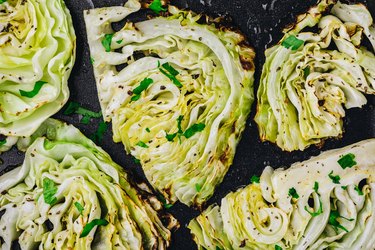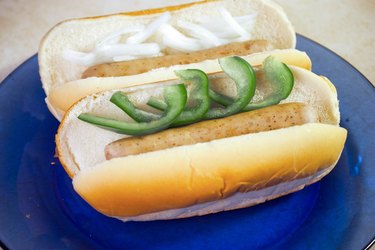Everyone enjoys corned beef briskets, but they don’t taste the same when they’re chilled. The good news is that you can reheat cold corned beef in a variety of ways to enjoy its flavor hot and fresh.
In this article, I’ll explain how to reheat corned beef using three different main techniques that I like to employ as well as a few additional techniques that will still warm corned beef but may not be as efficient.
When preparing leftovers for a large group, you can also use the same quantities of corned beef per person.
I’ll outline the benefits and drawbacks of each approach so you can decide which one best meets your needs.
No matter what, you can easily make your corned beef hot and delicious with my instructions!
How to Cook Corned Beef and Cabbage
When you have guests, you can prepare the corn beef brisket in advance and cook it with cabbage and other vegetables, like our Roasted Beets recipe. Since this tough cut of meat is frequently sold in grocery stores already cooked, it is perfect for those who are short on time.


According to Ohio State University, the reason why corned beef is pink is because it has been brined or cured using a combination of salt water and sodium nitrite. In general, it consists of brisket. The majority of recipes that call for it, like corned beef hash, are Irish in origin.
Purchase pre-brined corned beef from your neighborhood grocery store to save time. To avoid harsh chemicals, food additives, and artificial flavors, pick an organic option whenever possible. Since cooked corned beef is flavorful and tender, preparing it requires little time.
On a cutting board, chop the carrots, potatoes, onions, and other vegetables. Cut the cabbage into quarters. You could also include garlic, celery, herbs, and spices, depending on the recipe. Some chefs also add sugar, but its not really necessary.
In a Slow Cooker
To use a slow cooker, take the following actions:


- To a slow cooker, first add the vegetables and then the corned beef.
- Just enough liquid should be added to the slow cooker to cover the meat.
- Cover and cook on high for one hour. Change to the low setting and continue to cook for 10–12 more hours. According to the Ohio State University, if you’re in a rush, you can cook on the high setting for five to six hours.
- Add the cabbage in the last three hours of cooking. When the beef and cabbage are tender, your meal is prepared.
Another option is to use the stovetop for this recipe. Heres what you need to do:
- Place the corned beef fat-side up in a large stockpot. Add salt, herbs, and spices, or use the pre-mixed spice blend
- Fill the beef completely with water, beer, or broth.
- Bring to a boil, cover, and simmer for a while on low heat (about a pound of meat at a time).
- According to Ohio State University, add the cabbage and other vegetables in the final 20 to 30 minutes of cooking.
Here are the ingredients you’ll need to make baked corned beef and cabbage: a
- Add all ingredients to a large roasting pan. Place the meat fat side-up.
- Set the oven to 350 degrees Fahrenheit and sprinkle your preferred spices on top.
- Add a small amount of water—about 1/2 cup—to barely cover the beef.
- Cook until the meat and cabbage are tender. According to the USDA Food Safety and Inspection Service (USDA FSIS), if you’re using raw corned beef, you should cook it until the internal temperature reaches at least 145 F to ensure that all bacteria have been eliminated.
How to Reheat Corned Beef and Cabbage
Corned beef can be refrigerated for up to four days or stored in the freezer for up to three months, according to the USDA FSIS. Cooked meat dishes, including leftovers, can be kept in the freezer for two to six months or refrigerated for three or four days, per the U.S. Department of Health & Human Services.
In the oven, reheat corned beef and cabbage as follows:
- Just enough of the dish to serve as your next meal should be put in a medium pan.
- As advised by the USDA FSIS, rewarm it in the oven until the meat reaches a minimum internal temperature of 165 F.
Throw the beef away if it has a strange odor or if its color has changed.
Remember to watch your portions. Corned beef, whether you prepare it at home or buy it pre-cooked, is high in sodium, points out the University of Florida Health. For example, a 2-ounce serving of corned beef from Nestle boasts 550 milligrams of sodium, or 24 percent of the daily recommended intake. Plus, pre-cooked varieties often contain added sugar.
According to the American Heart Association, eating too much salt can cause your blood pressure to soar and increase your risk of stroke, kidney disease, heart failure, and osteoporosis. Additionally, it could result in bloating and fluid retention. Try not to consume more sodium per day than 2,300 milligrams to be safe.
People Are Reading 1
YT Main Reheat Corn Beef
FAQ
How do you reheat corned beef without drying it out?
Put in a sizable pan and fill with water, light beef stock, beer, or a combination of the two. 3. Estimate 7 to 10 minutes per pound for the liquid to gently simmer after it barely comes to a boil.
How do you reheat corn beef and cabbage?
For up to three days, keep leftover corned beef and cabbage in the refrigerator in an airtight container. Reheat the food in the oven until it is at least 165 degrees Fahrenheit inside.
How do you reheat corned beef and cabbage and potatoes?
How to Reheat Corned Beef and CabbagePour just enough of the dish into a medium pan for your subsequent meal. As advised by the USDA FSIS, rewarm it in the oven until the meat reaches a minimum internal temperature of 165 F.
Can corned beef be cooked a day ahead?
I often cooked Corned Beef a day ahead of time. I let the cooked meat sit and cool for roughly an hour. Following that, I put the meat in a freezer bag (typically a 2 gallon size, but whatever fits) with a cup or two of the cooking liquid (the liquid helps keep the meat moist).

